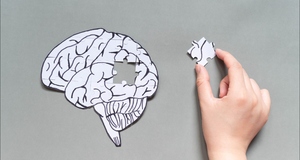Memories and Fear: Treatment Techniques to Dissociate Traumatic Memories
By
2016, Vol. 8 No. 03 | pg. 1/1
KEYWORDS:
Fear finds its place in the world through numerous forms, including natural disasters, genocide, war, trauma and countless other events which present lasting effects in the lives of those who maintain recollection. The research concerning the alteration of memories is a recent area of study, and while it could prove beneficial in regards to trauma and crippling fear, it also poses an ethical dilemma regarding a person’s identity. Memories associated with fear are seemingly permanently recorded by the brain and are unsusceptible to change. Yet as Michael Specter explained in a 2014 piece for The New Yorker, “the very act of remembering something makes it vulnerable to change” (245). Meanwhile, numerous experiments with humans involving shock and extinction training display the ability of the mind to be taught to rid itself of fear associated with a memory. The methods by which countless individuals have learned to overcome PTSD supports the idea that memories and their associations are subject to change, or disappear completely, over time. As a growing body of literature argues, memories are largely impermanent and can, if effectively amended at specific intervals of time, be disassociated from the fear that previously permeated them. Research is increasingly showing that memories are impermanent and with certain innovative treatments, they can be disassociated from the fear that previously permeated them.
While memories are often considered to be enduring, Specter (2014) shows the methods by which the mind can be modified in regards to memory recall. He provides results of numerous experiments which work to support the efforts of reconsolidation, which is defined as the neurological process through which long-term memories are elicited and then re-imprinted, and provides evidence of their effectiveness in cases involving PTSD, addiction, phobias and other issues related to harmful or disruptive memories. Specter introduces Daniela Schiller, a neuroscientist at the Mount Sinai School of Medicine in New York whose father, Sigmund Schiller, survived the Holocaust yet spent the majority of his life in silence regarding the experience.
Trauma victims frequently suppress the most debilitating memories, thus it is not surprising that Sigmund Schiller never spoke of any recollection he possessed concerning the early portion of his life, not even to those closest to him. This inspired his daughter’s work relating to the complex biology of the ways in which emotional memories are formed in the brain. Schiller wished to “find a way to rewrite our darkest memories” (251). She embarked on an experiment to see if humans would respond in the same manner as rats had in previous studies involving reconsolidation. Using propranolol, a common beta blocker which latches onto receptors in proteins and has been shown to successfully reconstruct memory formation in rats, Schiller’s study “offered the first clear suggestion that it might be possible to provide long-term treatment for people who suffer from PTSD and other anxiety disorders without drugs” (255). Michael Specter’s essay concludes with an unexpected turn of events when Daniela Schiller’s father, during filming for a documentary, discloses numerous intimate details concerning his life and the Holocaust. Daniela is in shock, as this is a version of her father she has never encountered. She claims, “[m]y memory has been updated. I have spent much of my life trying to find a way to reconsolidate my father’s memories, and ended up reconsolidating my own” (258). While she originally set out to find a way to reconstruct memories by way of science, she uncovered more proof that memories can be updated even with simple disclosure of information. These changes of memory resemble British philosopher, Ludwig Wittgenstein’s theory of aspect-seeing and shed light on the possibility for memory updating even in cases of long-term familial memories, and provide much hope for the future of memory reconsolidation. The more information that is disclosed, the more major the modification may be in victims and their circle of influence. Thus, medical intervention is not the only way by which memories can be altered, however, it is an increasingly promising area of study. Specter’s article supports the idea that the emergence of this new type of procedure intended to alleviate the paralyzing aspects of fear is a monumental breakthrough in science that should continue to be explored in further depth, as it has potential to be a widely successful method. As to the success and relevance of actively working to develop techniques which alter the lasting effects of fear, Sandkuhler and Lee (2013) claim “a focus on fear memory reconsolidation is the most promising approach to interfere selectively with long-term fear plasticity” (350). This article works to differentiate between protective and maladaptive fear and show the ways in which science can progress in order to rid an individual of extreme cases of anxiety and stress resulting from trauma. At the point that a memory is established, goes through consolidation and enters the maintenance phase, it remains subject to alteration. While many studies have argued that prevention of memory consolidation immediately following traumatic events is the most effective method, the work of Sandkuhler and Lee claims that the disruption of memory maintenance is more practical and effective due to the inability of many to access treatment immediately following traumatic events. This is the case in a large percentage of PTSD cases resulting from exposure to the violence that is often involved in war. Thus, this work argues that reconsolidation is the most important step towards eliminating crippling fear associated with memories in the long run. When examining whether or not reconsolidation is temporary and ultimately leads to the return of fear over an extended period of time, Björkstrand et al. (2015) examined its effectiveness over an eighteen-month period. Extensive research is conducted to test the lasting effects of reconsolidation and successfully proves its ability to separate an individual’s memory from fear. This article claims that “disrupting reconsolidation have long lasting behavioral effects and may permanently erase the fear component of an amygdala-dependent memory” (Bjorkstrand et al., 1). This differs from pharmacological and behavioral treatment, as relapses have previously proved to be common in both. To test their hypothesis, the group recruited thirty participants to take part in a discriminative fear-conditioning session involving electric shock. From this original group, twenty-two developed fear and twenty were re-tested after an eighteen-month period. In accordance with the results of Schiller, after an eighteen-month period fear returned only in those with undisrupted reconsolidation, and thus, their hypothesis was proved successfully. This article thoroughly explores the alteration of fear as it relates to memory retention, and effectively works to prove the notion that it is within the realm of science to alter individual's’ recollection of fear over the span of eighteen months. It provides much evidence that can support future research involving memory reconsolidation and works to strengthen the belief that it should be employed as a method of treatment for those suffering anxiety related disorders. While reconsolidation is increasingly proving to be an effective and lasting method of treatment, Soeter and Kindt (2013) discuss the role that predisposition to anxiety plays in the effectiveness of memory reconsolidation, and claims “trait anxiety impairs the fear-reducing effects of disrupting memory reconsolidation: the higher the trait anxiety, the less fear reduction” (7). While reconsolidation has proved effective in previous experiments involving a limited amount of subjects, it is a new method which has yet to truly explore the wide range of individual differences which play a role in the successfulness of memory reconsolidation, including predisposition to anxiety. Of the individuals examined in the study by Soeter and Kindt, those who were deemed vulnerable to develop an anxiety disorder proved to have limited success with fear reduction involving memory reconsolidation. Thus, individual predispositions largely impact the potential effectiveness of altering the relationship between fear and memories. Despite the current limitations of memory reconsolidation resulting from a lack of extensive research, this work addresses the potential need for refinement without discrediting its overall effectiveness. It reinforces the previous methods of altering memory recollection, while offering suggestions as to how it can be made more effective in order to successfully improve the lives of individuals who are predisposed to develop anxiety disorders. Although the previous methods involving visuo-spatial tasks have proved effective in altering memory formation during the period of consolidation, Pile, Barnhofer Wild (2015) address the fact that verbal techniques have not previously been employed in experiments concerning memory and fear retention. This poses a need for refinement of reconsolidation due to the fact that a large percentage of successful treatment for PTSD has historically been verbally-based. This article also examines the factors which contribute to development of PTSD, thus providing evidence concerning memory retention from an angle which has not previously been explored. The study included 113 participants who underwent a trauma-film paradigm involving a screening stage, experimental session and a one-week follow up period. The conclusion of the study supported the group’s initial hypotheses, and the article claims “devaluing the trauma memory with a verbal intervention successfully reduced distress associated with the conditioned stimulus and prevented development of symptoms” (Pile, Barnhofer, and Wild, 16). Thus, preventing fear from overtaking the memory in the first place. This supports the idea that in order to best alleviate individuals suffering from PTSD, verbal techniques should be employed shortly after the initial trauma, as they have been found to be effectual. This research contributes significantly to the scientific community, as it shows the ways in which the previous methods to alter fear retention can be expanded to reach a more diverse group through the incorporation of verbal techniques. In regards to the expansion of memory reconsolidation treatment Lavazza (2015) addresses the ethical implications of tampering with memory. In regards to these potential issues, she claims “individual autonomy in memory-erasing seems to be subjected some limitations . . . [s]uch limits derive from the constraints of social life, which entail that, in some cases, the very pre-conditions of autonomy could be put at risk by the massive use of techniques of memory-erasing” (Lavazza 6). Thus, the process of tampering with unpleasant memories is relatively new, and it is of great significance to consider the ethical implications of such treatments in the early stages. When examining the lasting implications of modifying memory, Lavazzo claims “this goes against the principle of authenticity and, on the other hand, it has important consequences both for the person who makes up her memory and for those with whom she interacts. And when the conformity between memory and reality is lost, the consequences are often dysfunctional and negative” (8). The identity of an individual is something which is to be respected, and the treatment of fear-oriented disorders through processes such as memory reconsolidation potentially infringes upon individual autonomy in a way which has not previously been observed as it has only recently entered into the realm of possibility. While, the potential ethical implications of memory reconsolidation are important to consider, far more studies would need to be conducted to support that it is completely unethical, and should cease to be conducted. It has proved successful in numerous instances, and should continue to be explored while taking ethics and the respect for individual autonomy under serious consideration. Memory reconsolidation is an incredibly innovative treatment for anxiety related disorders which potentially needs refinement in various areas, however, the recent work of numerous researchers shows the possibility for long-term alteration of memories involving fear and this yields much hope for the future. This type of treatment is relatively new, thus it important to consider the implications involving individuals who are predispositioned to respond differently to reconsolidation, and the ethical considerations of tampering with an individual’s identity. Memory reconsolidation has the potential to prove largely effective in the lives of those with PTSD and other disorders which hinder individual’s ability to live their lives without the constant presence of maladaptive fear. However, if it is at the expense of individual autonomy, it is an area which needs far more refinement and examination before being performed broadly to treat those who suffer from fear and anxiety disorders. Regardless, the recent studies provide much hope for future treatment, as trauma is an unavoidable part of life for the large majority of individuals, and furthering scientific exploration and treatment involving memory reconsolidation could provide the masses with an efficacious method by which to cope with severe anxiety and stress resulting from trauma. ReferencesBjörkstrand, J. et al. "Disruption Of Memory Reconsolidation Erases A Fear Memory Trace In The Human Amygdala: An 18-Month Follow-Up." Plos ONE 10.7 (2015): 1-8. Academic Search Complete. Web. 27 Oct. 2015. Lavazza, A. "Erasing Traumatic Memories: When Context And Social Interests Can Outweigh Personal Autonomy." Philosophy, Ethics & Humanities In Medicine 10.1 (2015): 1-7. Academic Search Complete. Web. 19 Nov. 2015. Pile, V., Barnhofer, T. and Wild, J. "Updating Versus Exposure To Prevent Consolidation Of Conditioned Fear."Plos ONE 10.4 (2015): 1-21. Academic Search Complete. Web. 27 Oct. 2015. Sandkühler, J., and Lee, J. "How to Erase Memory Traces of Pain and Fear." Trends in Neurosciences 36.6 (2013): 343-52. Print. Soeter, M., and Kindt, M. "High Trait Anxiety: A Challenge For Disrupting Fear Memory Reconsolidation." Plos ONE 8.11 (2013): 1-8. Academic Search Complete. Web. 27 Oct. 2015. Specter, M. "Partial Recall.” The New Yorker. May 19, 2014: 16-25. Rpt. in The Best American Science and Nature Writing 2015. Ed, Skloot, Rebecca. Boston: Houghton Mifflin Harcourt, 2015. 244-260. Print. Suggested Reading from Inquiries Journal
Inquiries Journal provides undergraduate and graduate students around the world a platform for the wide dissemination of academic work over a range of core disciplines. Representing the work of students from hundreds of institutions around the globe, Inquiries Journal's large database of academic articles is completely free. Learn more | Blog | Submit Latest in Psychology |


















